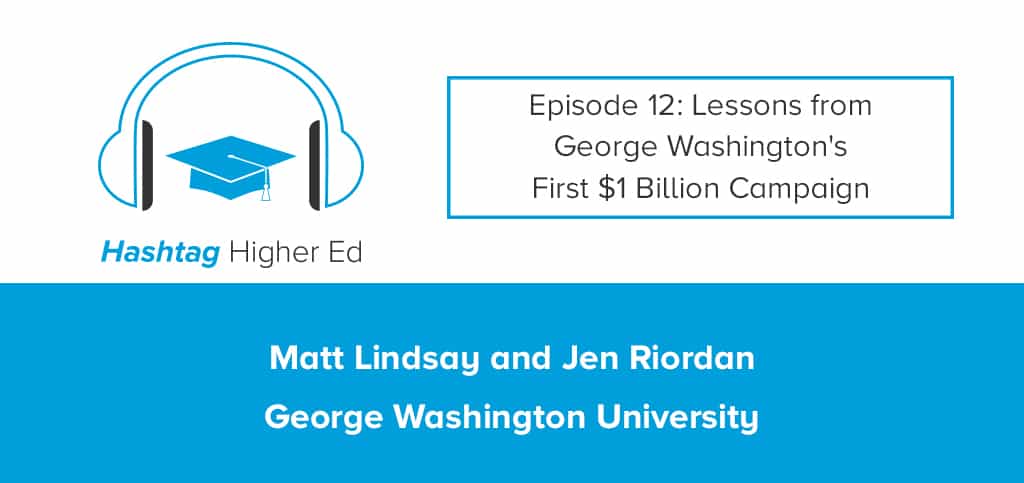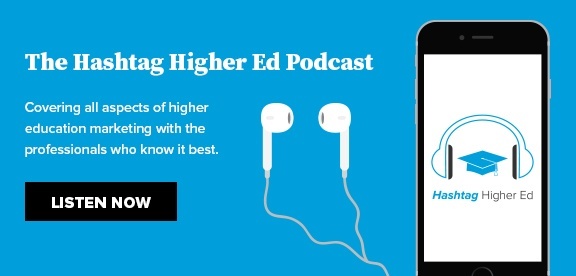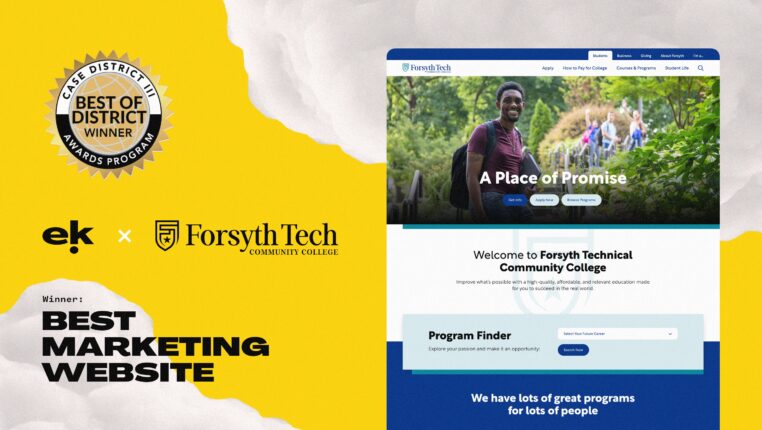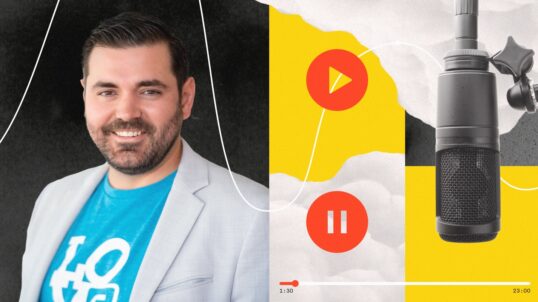Back in 2011, George Washington University embarked on a long journey with a lofty goal. Its “Making History” campaign would be the school’s third major comprehensive campaign and its first campaign to raise one billion (yes, with a b) dollars.
Six years later, and one year earlier than expected, George Washington University successfully closed the “Making History” campaign. At its conclusion, it was the largest capital fundraising campaign in its history, with more than 66,000 donors contributing more than one billion dollars.
Raising a billion dollars is no easy feat. It takes a great deal of planning, outreach, marketing, and one-to-one stewardship. To learn more about this impressive fundraising campaign, we were fortunate to welcome Matt Lindsay, the Executive Director of Digital Strategy and Engagement, and Jen Riordan, Executive Director of Donor Relations, to the Hashtag Higher Ed Podcast.
Creating a Unified Message
To successfully complete this robust and transformative campaign, George Washington knew it needed to create a unified message. That can be a massive undertaking at a large institution like George Washington. “I give the leadership office in our university a lot of credit,” says Lindsay. “Our university leadership team really looked at this as one campaign. They provided teams with resources and made sure that the messaging in the campaign was aligned with other major university initiatives.”
Part of the challenge in creating a unified message was that the messaging itself was being updated. “There were really three things happening around the same time,” says Lindsay. “Our Development Office and the Department of Alumni Relations were planning for the largest campaign ever in the history of the university; our External Relations division was working on updates to our brand and identity; and our Provost’s Office was leading a new strategic planning initiative.” Luckily, Lindsay adds, each group was cognizant that despite different desired outcomes, it would be best for the university if these efforts works in concert with each other.
In many ways, however, the “Making History” campaign acted as the impetus needed to reinforce GW’s message. “I think the campaign afforded us the opportunity to reinforce the messaging that we use in working with different schools and units as we talk about the importance of using donor funds,” adds Riordan. “The campaign gave us the vehicle to say, ‘listen, this is a special time. We have very lofty goals that we’re trying to achieve and we need your help.’ So I think the campaign helped to further build those relationships and again, bring unity to what we were all trying to do and accomplish together.”
Adapting the Marketing Message
While GW reinforced its message, it was also tasked with adapting that message for its various audiences. And when campaign success depends on reaching hundreds of thousands of donors, audience segmentation is required. “I think the most important group, when we think about different audience types and making sure that they understand the message of the campaign, is current donors,” says Lindsay. “It’s crucial that they see a sense of momentum, understand the vision of leadership, and see this as an opportunity to change and improve the university.”
“The campaign gave us the vehicle to say, ‘listen, this is a special time. We have very lofty goals that we’re trying to achieve and we need your help.’” – Jen Riordan
But while George Washington made sure to have a focused marketing message to principal donors, it also recognized the need to be able to effectively communicate with alumni and prospective donors who weren’t able to give a large amount of money. After testing potential messages, Lindsay says, they realized that the most effective message for lower-level donors centered on the collective power of philanthropy. “It’s about pooling those resources,” says Lindsay. “We want to show how through a combination of gifts, we were able to allow a student to attend GW and have this world-class education. It’s about showing the real faces and the real people that will be impacted.”
George Washington also adapted its messaging for those who were just reaching their philanthropic starting line. “During the silent and public phase of this campaign, we really focused on building our senior class giving program and encouraging participation more broadly amongst our undergraduate alumni population,” says Riordan. By running the campaign on a parallel track to the annual giving initiative, says Riordan, GW was able to communicate to students that while they weren’t expected to give at a high level, they were an important part of the process. “Building that culture of giving back from day one, while you’re still on campus, is more of a long-term perspective.”
Maintaining Philanthropy Levels Post Campaign
Part of that long-term perspective included donor messaging post campaign. “We were very cognizant of the fact that a billion dollars is a lot of money,” says Lindsay, who adds that when GW concluded its campaign, it made sure that their messaging didn’t use words like “done” or “finished.”
“We celebrated campaign milestones and achievements, but we still have need. We cannot provide the amount of need-based financial aid that we’d like to. There are still students who would like to attend GW and are qualified to attend, but cannot because of resources. That’s an ongoing challenge that is not solved with one campaign.”
Thanking Donors
But while the need for donor contributions still exists, appreciating and acknowledging the impact donors had on George Washington through their “Making History” campaign was important. So important, say Lindsay and Riordan, that the planning for their campaign conclusion started well before their $1 billion campaign fundraising goal was within reach. “We decided pretty early on that we weren’t going to follow the more traditional forms of recognizing donors at the end of the campaign,” says Riordan. “As an institution, we had done away with more traditional forms of honor rolls and lists of donors.”
“I think the most important group, when we think about different audience types and making sure that they understand the message of the campaign, is current donors.” – Matt Lindsay
Riordan says that throughout the campaign, GW collected content on how donors’ funds were being used. “We were collecting a number of stories and using them in different digital properties and print publications. So that by the end of the campaign, we had a vast collection of stories that could be curated into telling the broader story of the campaign.”
Ultimately, George Washington chose to share that collection of stories through a campaign microsite. “We decided to move forward with a microsite because we wanted to have relevant content, in a variety of styles, that people could consume and share,” says Lindsay. “We wanted it to be focused on storytelling and drawing people in.”
“It’s about the difference that [donor’s] gifts made on people’s lives,” adds Riordan. “Because it’s a gift, but it’s also an investment in the university and GW culture.”
Special thanks to Matt and Jen for joining the Hashtag Higher Ed Podcast. You can find Matt Lindsay and Jen Riordan on LinkedIn, and Matt on Twitter at @lindsam8. To learn more about GW’s “Making History” campaign and to see the campaign impact microsite, visit makinghistory.gwu.edu.
Listen to this episode, and previous episodes of the Hashtag Higher Ed Podcast, on Soundcloud, iTunes, Google Music, or wherever podcasts are found. To explore previous episodes of the Hashtag Higher Ed podcast and sign up for alerts regarding new episodes, visit our Hashtag Higher Ed hub.




